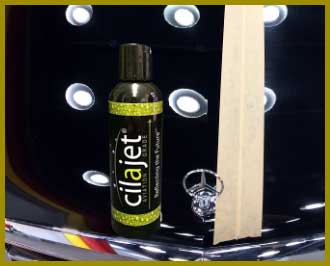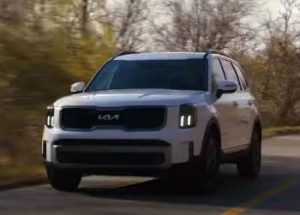Let’s talk about your car’s coat. Is it glossy and slick, or has it lost that new car sheen?
If you’re in the market for a high-quality paint protector, chances are you’ve heard about both Cilajet and ceramic coating. But which one is right for you and your four-wheeled friend?
A Brief Comparison Table
| Factors | Cilajet | Ceramic Coating |
| Origins and Composition | Originally formulated for the aerospace industry, based on a synthetic hydrocarbon compound. | Born in the automotive industry, based on a liquid polymer. |
| Application Process | Requires near-perfect surface conditions and professional application. | Can be done as a DIY project, but professional application is recommended for best results. |
| Maintenance | Easy to maintain; dirt and grime wash off easily. | Requires regular washing to maintain its protective properties and gloss. |
| Durability | Can last up to 10 years with proper care. | Durable but may show signs of wear over time; not completely scratch-proof. |
| Cost | Can be costly, especially if professionally applied. | Can also be costly, but the price can vary based on several factors including product quality and the professional’s experience. |
The Skinny on Cilajet

First off, let’s break down what Cilajet is.
Designed initially for the aerospace industry, Cilajet is a sealant that uses advanced nanotechnology to protect and enhance your vehicle’s appearance.
This high-tech solution promises a mirror-like finish that will have heads turning.
Pros of Cilajet:
- Longevity: Once applied, Cilajet can last up to 10 years on your car, a period that undoubtedly will make your investment worthwhile.
- Scratch Resistance: The layer it provides adds a level of protection against light scratches, bird droppings, and bug splatter.
- Ease of Maintenance: Post-Cilajet application, your car becomes a breeze to clean, with dirt and grime easily washing off.
Cons of Cilajet:
- Professional Application: Cilajet needs to be professionally applied, making it a potentially costly process.
- Surface Preparation: Your car’s exterior has to be spotless before application. Any imperfections trapped under the coating could lead to undesirable results.
All About Ceramic Coating
On the other side of the coin, we have ceramic coating. Ceramic coating is a liquid polymer that chemically bonds with your vehicle’s paint, creating a layer of protection.
A popular choice among car enthusiasts, ceramic coatings can keep your ride looking fresh-off-the-lot for years.
Pros of Ceramic Coating:
- Durability: Ceramic coatings are hardy. They protect your vehicle from UV damage, oxidation, and chemical stains.
- Hydrophobic Nature: One of the key features of ceramic coatings is their hydrophobic, or water-repelling, properties. This means water will bead on the surface and slide off, taking dirt with it.
- Enhanced Gloss: Ceramic coatings add depth and gloss to your car’s paint, improving its aesthetics.
Cons of Ceramic Coating:
- Cost: Similar to Cilajet, a professional application can be costly.
- Requires Regular Maintenance: Ceramic coated cars need to be washed frequently to maintain their look and protection level.
- Not Completely Scratch-Proof: While they offer protection, they are not entirely immune to deep scratches or chips.
Key Differences Between Cilajet And Ceramic Coating
While both Cilajet and ceramic coating aim to protect your car’s paint and improve its aesthetics, there are a few key differences between these two that you should consider.
- Origins and Composition

Cilajet and ceramic coatings have different origins, which lead to differences in their composition.
Cilajet was initially formulated for the aerospace industry, providing high-end protection for aircraft.
Its key ingredient is a synthetic hydrocarbon compound that creates a thin, smooth, and mirror-like finish on the car’s exterior.
On the other hand, ceramic coatings were born in the automotive industry, with the primary component being a liquid polymer.
When applied, this liquid polymer bonds with the vehicle’s factory paint, forming a durable layer of protection.
- Application Process
The application process for Cilajet and ceramic coatings also differs. Cilajet requires the car’s surface to be in a near-perfect condition for effective application. A certified professional should do the application as it demands a high level of precision and skill.
Ceramic coatings, though also preferably applied by a professional, can be done as a DIY project. However, the process is meticulous and time-consuming, requiring a clean, well-prepared surface and careful application to prevent streaking or high spots.
- Maintenance and Durability
Maintenance and durability also set these two options apart. Cilajet is known for its ease of maintenance. After the application, dirt and grime wash off easily. The sealant can last for up to 10 years with proper care, offering long-term protection.
Ceramic coatings, while also durable, demand regular washing to maintain their gloss and protection. They are not completely scratch-proof and may show signs of wear over time.
Nevertheless, the hydrophobic nature of ceramic coatings provides an impressive self-cleaning effect as water beads off, taking surface dirt along with it.
- Cost
While both options can be costly, especially if professionally applied, the price can vary based on the product’s quality, the professional’s experience, and the size and condition of the car.
Always remember to balance cost with quality to get the best value for your investment.
To put it simply, both Cilajet and ceramic coating offer excellent protection for your car, but they each have their unique strengths and drawbacks. Your choice between the two ultimately depends on your personal preferences, lifestyle, and budget.
Also Read: Differences Between Ceramic Coating And Eckbond.
Frequently Asked Questions (FAQ)
No, they aren’t the same. Cilajet is a sealant, while ceramic coating is a liquid polymer. Both offer protection and enhance your car’s appearance but have different chemical compositions and properties.
Cilajet can last up to 10 years on your vehicle with proper maintenance. It’s designed to provide long-lasting protection and aesthetic enhancement.
Yes, you can. In fact, washing your car is easier post-Cilajet application. However, it’s recommended to use a touchless car wash to maintain the integrity of the Cilajet coating.
Cilajet adds a level of protection against light scratches. It isn’t a foolproof shield, but it does provide an additional layer that can help prevent minor surface damage.
Wrapping Up
Your car is an investment, and both Cilajet and ceramic coating provides a layer of armor to protect that investment. Whether you choose the aerospace-grade sealant or the robust liquid polymer, you’re taking a step towards preserving your vehicle’s shine and longevity.
So, make your pick, schedule an application, and let your car gleam with pride. Happy driving!



